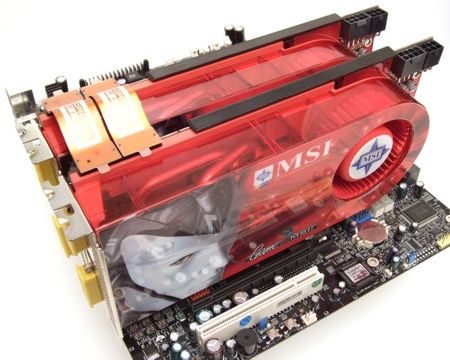6 Graphics Cards with Luxury Trimmings
MSI Radeon HD 2900 XT Crossfire
A tandem of Radeon HD 2900 XTs is the fastest Crossfire configuration currently offered by ATI.
Crossfire Performance In Windows XP
Adding a second graphics card boosts the frame rate in Battlefield 2142 by 11% to 62%, with higher resolutions benefiting the most from the second card. The maximum performance boost in Doom 3 is 35%, and only manifests itself in high resolutions with anti-aliasing enabled. At 1024x768 with all filters disabled, the dual-card setup actually runs slower than a single-card system. Oblivion greatly benefits from the second card, almost doubling its performance. The added performance ranges from 55% to 84%. Even in the 1920 resolution, the game still skims along at a brisk 40.5 fps, while a single card runs at only 22 fps.
Prey behaves just like Doom3, with the second card actually slowing the game down at 1024x768 with filters disabled. At higher resolutions, Crossfire yields between 22% and 72% more performance. The cumulative performance delta between the single Radeon HD 2900 XT (1809.6 fps) and the Crossfire configuration (2197.1 fps) amounts to 387.5 fps, or 21.4%.
Crossfire Performance In Windows Vista
The Catalyst 7.9 driver still seems to offer rather poor support for Crossfire configurations under Vista. None of Bioshock, Company of Heroes nor World in Conflict displayed a performance gain. On the contrary, the tandem configuration actually ran slower than the single-card setup. Lost Planet can benefit from the second card's rendering power with FSAA enabled, gaining between 65% and 79% more performance. As before, we can see the same pattern: the higher the resolution, the higher the performance advantage over a single card.
Both noise and temperature increase in a Crossfire configuration. While a single Radeon HD 2900 XT remains very quiet in 2D mode, the fans spin up briefly every now and then with two cards running in tandem. Where a single card's heat output ranges between 62°C and 82°C, the dual card setup produces 10°C more. Unsurprisingly, the noise level is also higher in 3D mode, measuring up to 54 dB(A) for the Crossfire setup, compared to a single card's 51.4 dB(A).
Get Tom's Hardware's best news and in-depth reviews, straight to your inbox.
Each of our review samples came with a flexible Crossfire bridge. Two such bridges are required so that the two cards can detect each other and combine their rendering power. If you plan to build a Crossfire system, check with your store to ensure that your cards come with all of the required equipment, including these connectors.
Current page: MSI Radeon HD 2900 XT Crossfire
Prev Page MSI Radeon HD 2900 XT Next Page MSI Radeon HD 2600 Pro Noise Free Edition Crossfire